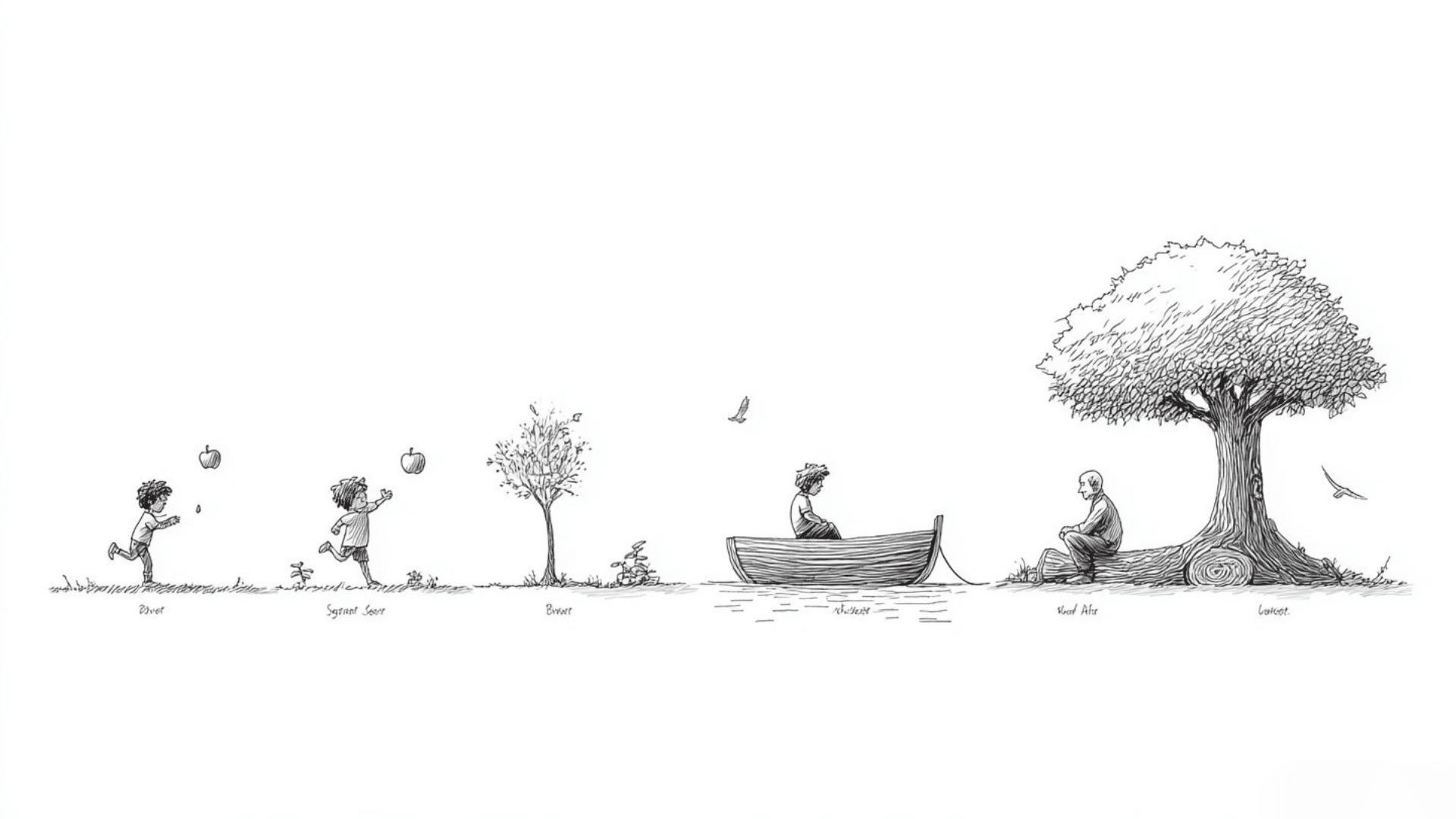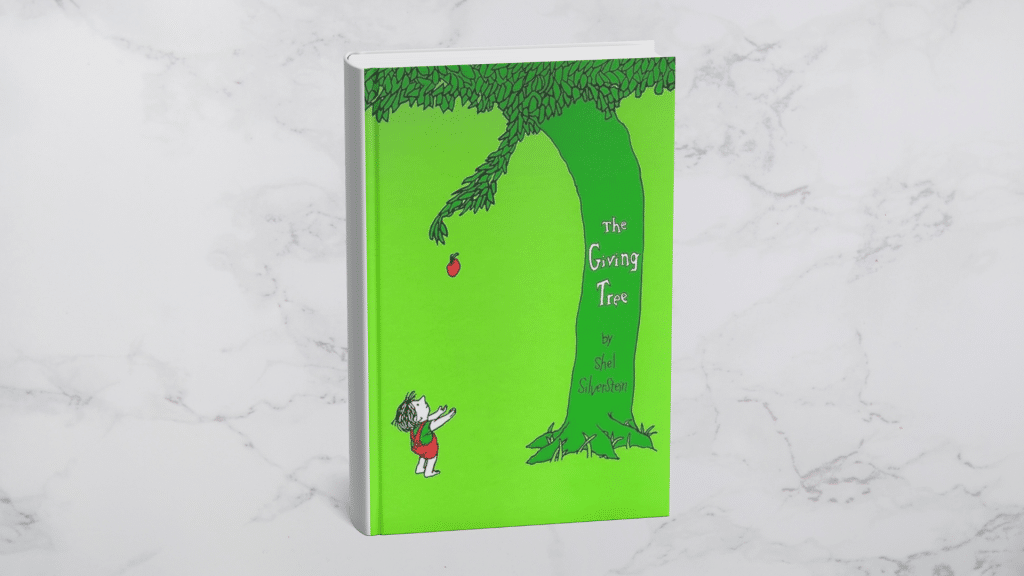When I first picked up The Giving Tree by Shel Silverstein, I was surprised by how such a short book could leave such a long-lasting impression.
Since its release in 1964, this story has been read to kids, discussed in classrooms, and debated by adults who see very different lessons in its pages.
If you’ve read it before, you probably remember the boy and the tree, and how their relationship changes over time.
Some people see it as a touching story about unconditional love, while others feel it shows an unfair kind of giving that leaves nothing behind.
As you read along, you’ll see why this little book is still beloved – and why it stirs up strong feelings even today.
Summary of The Giving Tree

The Giving Tree by Shel Silverstein is a simple yet powerful tale that captures the lifelong bond between a boy and a tree.
In his childhood, the boy spent joyful days climbing the tree’s branches, swinging from them, eating its apples, and resting in its shade. The tree feels complete happiness just by seeing him happy.
As the boy grows older, however, his visits become less about play and more about fulfilling his needs. When he asks for money, the tree gives him her apples to sell
Later, when he needs a house, she offers her branches. Still later, when he longs for adventure, she gives him her trunk to build a boat. Each time, she willingly sacrifices a part of herself, even though it leaves her weaker and smaller.
Eventually, the boy returns as a tired old man with little left to ask for. By now, the tree has been reduced to a stump, and she feels she has nothing left to offer. Yet all the old man wants is a quiet place to sit and rest. The stump provides that final gift, and the tree is happy once more.
This timeless story resonates across generations because it speaks to themes of unconditional love, sacrifice, and the complex balance between giving and taking.
It invites readers to reflect on relationships between parents and children, people and nature, or givers and receivers, and to ask what it really means to care for someone.
Main Themes and Messages
The Giving Tree is more than just a children’s story – it carries deep themes and messages that invite readers to think about love, gratitude, and our connection to nature
- Unconditional love and sacrifice: The tree gives to the boy repeatedly without expecting anything back, showing deep devotion often linked to parental love.
- The nature of giving and gratitude: The tree finds joy in giving, but the boy rarely shows thankfulness, raising the question of whether happiness comes from giving, receiving, or balance.
- Human relationships with nature:The boy’s constant taking symbolizes how people often use natural resources without considering long-term consequences.
- A final warning: The tree ends as a stump, reminding us of what happens when too much is taken without giving back.
Buying Guide: How to Get The Giving Tree
If you’re planning to buy The Giving Tree, here’s what you need to know about different editions, where to find them, and typical prices to help you choose wisely:
| Edition | Description | Typical Price Range | Best For |
|---|---|---|---|
| Hardcover | Classic, durable edition: great for family reading or display. | £12-£20 in the UK (e.g., £12.99 at Waterstones); about $20 in the US (Barnes & Noble). | Long-term use, family reading, gifts |
| Paperback | Lightweight and budget-friendly. | $8-$10 (varies by retailer). | Every day reading, portable option |
| Board Book | Sturdy and easy to handle, designed for younger children. | $10-$15 (estimated typical range). | Toddlers, young kids, bedtime reading |
| Collector’s / Anniversary | Includes special editions like the 50th anniversary release with metallic/embossed designs. Vintage first editions are also available. | £4-£9 for newer commemorative editions; £74+ for rare/vintage first editions. | Collectors, gifting, display, keepsakes |
Where to Buy
There are plenty of ways to get a copy of The Giving Tree, from new editions at major retailers to affordable used copies and even free library loans.
- Online retailers, such as Amazon, Barnes & Noble, and Waterstones, offer a wide variety of editions, often with fast delivery and pricing transparency.
- Local Bookstores: Ideal for seeing the book in person, Waterstones charges about £12.99 for a standard hardback
- Libraries: A great free option – libraries almost always carry The Giving Tree, given its popularity and classic status.
- Used & Rare Book Sellers: Sites like AbeBooks, Alibris, and eBay offer used copies starting as low as $1-$2 for older paperbacks or library copies, while collectible first editions may reach £70+.
Different Interpretations of The Giving Tree
This book has sparked many different interpretations over the years. While some see it as a touching story of love and sacrifice, others view it as a cautionary tale about imbalance and exploitation.
1. A Story of Selfless Love (Parental or Maternal)
Many readers see the tree as a parent figure, giving everything for the child’s happiness. The unconditional sacrifice is often compared to the love a mother or father shows, even when the child doesn’t always give back.
2. A Cautionary Tale of Imbalance and Exploitation
Others believe the story is not just about love but about taking advantage. The boy never learns gratitude, and the tree loses everything. This view highlights the dangers of one-sided relationships where giving has no limits.
3. Feminist and Environmental Critiques
Some critics argue the tree represents a woman who gives up her entire self, raising concerns about unhealthy expectations placed on women to sacrifice endlessly. From an environmental angle, the book is also seen as a metaphor for how humans exploit nature until nothing is left.
Why the Story is Conventional
The Giving Tree has been loved by generations, but it’s also one of the most debated children’s books.
The main controversy comes from the question of whether the tree’s constant giving is a healthy act of love or an unhealthy form of sacrifice.
Some readers see it as a touching reminder of how powerful selfless love can be, especially in the way parents care for their children.
Others, however, feel the story encourages harmful behavior, showing a one-sided relationship where one gives everything and the other only takes.
- Uplifting View: Many readers see the book as heartwarming, simple, and comforting because it shows a love that never runs out.
- Critical View: Others find it depressing or unsettling, noting the boy’s lack of gratitude and the tree’s eventual destruction.
Lessons for Children and Adults
The Giving Tree carries lessons that change with age. For children, it’s a simple story about sharing, kindness, and caring for others. Kids connect to the boy’s friendship with the tree and learn that happiness often comes from giving.
For adults, the meaning is deeper. It raises questions about boundaries, relationships, and sustainability. Adults reflect on love, sacrifice, and the need to balance giving with self-care. It also reminds us of how humans often take too much from nature.
Modern Relevance: Though written in 1964, the story still feels current. Many see it as a warning about overusing nature’s resources, linking it to climate change and caring for the planet.
It also highlights the importance of giving with limits so kindness doesn’t erase self-care.
Conclusion
The Giving Tree has remained with readers for more than half a century because it speaks to universal experiences -love, sacrifice, gratitude, and the complex balance between giving and taking.
Each generation finds something new in its pages. For some, it’s a gentle reminder of a parent’s love. For others, it’s a warning about overuse, imbalance, or even the way we treat the natural world.
What makes the book so powerful is that it doesn’t give you one answer; it leaves space for you to think about what the story means in your own life.
Take a moment to reflect: are you more like the boy, or the tree? What does giving and receiving look like for you? If you haven’t read the book in a while, pick up a copy and see what lessons it offers you today.











